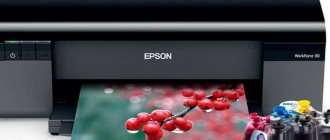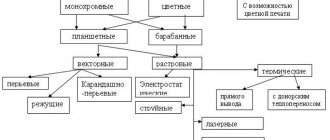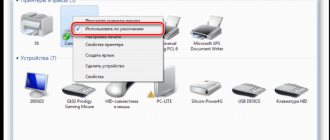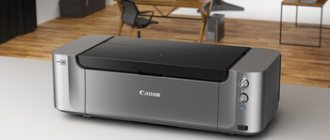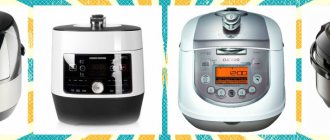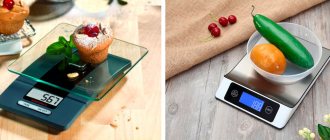2019-2-6 12:15
The printer is a conveyor belt that serves the office, and an indispensable assistant at home if you are studying at university. Electronic documents and communication over the Internet are, of course, good, but no 21st century can force a person to give up paper. Printing out a contract for signature, term paper or just photographs to frame them and hang on the wall - you can’t do without a printer.
In this article we will give a brief overview of the types of printers, try to compare them and understand which is better, and also give advice on which printer is better to buy.
Types of printers: device
In terms of design and operating principle, there are three types of printers: matrix, inkjet and laser.
- A dot matrix printer is an older type of printer. Its operation is carried out as follows: the print head, consisting of a set of needles (matrix), moves line by line along a sheet of paper, and the needles hit it in a certain order through the ink ribbon, leaving points from which the image is formed. About 20-25 years ago this was the main type of printer, but now they are used in cash registers for printing receipts. Our passports are also printed on dot matrix printers!
- An inkjet printer works similarly to a dot matrix printer, only instead of needles it has a matrix with holes through which ink - black or colored - is sprayed pointwise. An image is formed from dots of paint. Ink is supplied in special modules - cartridges, which must be purchased separately. There is also a continuous ink supply system (CISS): a special print head is built into the printer, to which ink is supplied from reservoirs through thin tubes. In this case, it is enough to periodically buy ink and add it to the reservoirs.
What types of printers are there?
Matrix
An outdated model invented by the Japanese in the 70s. last century. The design has common features with a typewriter. They differ only in that a dot matrix printer can have from 9 to 24 print heads (needle matrices) striking the ink ribbon. The heads are driven by electromagnets. The extreme head prints the text onto paper. The needles have different diameters, which determine the diagonal of the dots that form the symbols. The medium on which text or images are displayed is special roll or fan-fold paper.
Matrix boxes have an outdated design. The use is relevant for banks, cash desks and other similar institutions. The printed inscription cannot be edited or changed imperceptibly; it is resistant to moisture and erasure.
Flaws:
- monochrome;
- low print speed;
- noise (up to 25 dB).
Jet
Creates a drawing on paper with dots, but using a matrix that prints with liquid ink. There are small nozzles along the cartridge or print head through which ink flows onto the paper.
The ink must have a certain consistency. Too thin ones will take a long time to dry on paper, and thick ones will quickly clog the nozzles.
Inkjet printer nozzles must be periodically cleaned of dust, debris, and dried ink. To prevent the ink from drying out, you need to print frequently. Read: how to clean the print head nozzles.
If the printer has several cartridges, then it can print in color. Can install a continuous ink supply system. One full refill of the ink tank is enough to print at least 500 pages.
Depending on the method of application, inks are classified into piezoelectric and thermal.
- Piezoelectric. The technology is used by Epson and Brother. They print with high quality thanks to the reduced droplet diameter.
- Thermal. The nozzles are constantly heated to force the dye through them. Due to high temperatures, equipment often breaks down. The technology is used by brandy HP, Xerox, Canon, Epson.
Classification by purpose:
- Office. Used in offices, printed on A4 sheets.
- Widescreen. Designed for printing advertising stands.
- Interior. Posters and decor are printed.
- Marking. Designed for marking.
- Photo printers. Print out photographs.
- Souvenirs. They apply images to objects of various shapes: smartphones, disks, lighters, etc.
- Manicure. Apply a design to the nails.
Laser
They work using photocopying technology, which has been known since the beginning of World War II. The main structural element of laser printers is the photo roller, which holds an electrical charge.
The laser hitting the photodrum changes the charge only in a certain area. Powder dye – toner – is applied on top of the roller. It is magnetized only in places where the charge does not coincide with the surface of the shaft. This creates an image that is transferred to paper. Under the influence of high temperatures, the powder is baked and remains on a sheet of paper.
Advantages of laser printers:
- low noise level;
- low cost of consumables;
- reliability, unpretentiousness;
- The carrier can be paper, film, cardboard, textiles.
Color printers are worse in print quality than inkjet printers and are much more expensive.
With CISS
The device supplies dye from the jars through tubes to the inkwell. CISS allows you to save on the purchase of parts that improve the quality of the printout. To charge the cartridge there is no need to contact a service center; the dye is changed by the user independently. The printer can be equipped with CISS from the factory, or you can install the system after purchasing the device.
MFP
Multifunctional device - simultaneously performs the functions of a printer, scanner and copier. They are purchased for large offices where you need to work with large volumes of printed information. The scanner in the device reads data from printed sheets and converts them into electronic format on a computer (scanned copy). Information in electronic form can be stored and processed. The photocopier makes copies of already printed pages. Due to their large dimensions, MFPs are often installed in offices, but there are also compact models for home use. There are inkjet and laser MFPs.
Sublimation
Also called thermo-sublimation. Can print images and text onto thick material like plastic. Inside the device there is a black, color and protective cartridge.
A sublimation printer applies an image using the following algorithm.
- The carrier is heated to the required t °C.
- Dye is introduced into its micropores at high speed.
- Ink of different colors is applied alternately, as in inkjet printing.
- A protective layer is applied on top of the main dye, which prevents the ink from washing out, fading and erasing.
LED technology
The operating principle is comparable to laser technology. LED cameras have a different light source that changes the charge on the photodrum. Instead of a laser, 2.5-10 thousand LEDs are installed. A separate LED is responsible for each dot printed on the paper, which results in high-quality printing. Due to the lack of mechanical elements inside, LED printers are less prone to mechanical failures.
Thermal printer
The image is transferred by heat-sensitive media, in particular heating elements or infrared radiation created by LEDs. Thermal printers print on surfaces of different densities and hardness:
- textile;
- glass;
- mirror;
- phone case;
- human skin (tattoo printer);
- food products (coffee or tea serves as ink);
- nails;
- candles;
- flower petals.
The thermal printer can print in Braille.
3D printer
You can print three-dimensional parts from specific materials. There are home and office models. Widely used in medicine and other professional fields.
A 3D printer can be inkjet or laser, and the dye is polymers or powder. There are separate developments that print with magnetic dust, sand or clay. 3D food devices are used in cooking.
Drum printers
The advantage is greater speed of operation.
Nowadays they are not used. Inside the printer is a drum whose width matches the width of the page. Relief symbols are placed on the shaft. As the shaft rotates, it hits the paper with a metal tip, creating image elements similar to a typewriter.
Chamomile or petal
Based on the printing principle, printers are similar to drum printers, but the characters are on rotating disc blades. The piece of paper touches the ink ribbon and leaves an imprint on the paper. By changing the shade of the tape, you can make color prints.
Which printer is better? Advantages and disadvantages
- If we compare different types of printers, then we probably shouldn’t talk dot matrix printers We can only say that they print slowly, with a characteristic unpleasant sound, quite pale and, most importantly, only one color, which is specified by the printer manufacturer (usually black or blue).
- Inkjet printers , by the way, can differ in printing speed from dot matrix printers by only a few seconds. But they are much quieter, have a wider range of applications and are capable of printing in different colors. That being said, the inkjet printer is a gadget known for its capriciousness. They need to be used regularly so that the paint in the cartridges does not dry out; You cannot use paper that is too thin or too thick with it - it can get stuck in it (a fairly well-known bug). But the biggest drawback is the high cost of maintenance: the paint in CISS cartridges and tanks runs out quite quickly, and you need to constantly repurchase it.
- A laser printer , on the contrary, has a high printing speed of 10-20 pages per minute. It is quite noisy, but extremely multifunctional. An interesting advantage of a laser printer is its ability to print on almost any paper, such as thermal transfer or tracing paper. The disadvantage of a “laser printer” is its high cost (although it is not known whether this is a disadvantage or an advantage: a laser printer is more expensive to buy, but much cheaper to maintain - the toner runs out more slowly), as well as the difficulty of refilling: if you can insert a cartridge into an inkjet printer yourself, to replace the toner in laser, you often have to invite a specialist.
Which printing technology to choose
Printing technology determines not only the quality, but also the speed of printing. The most popular devices include models of inkjet, laser and sublimation printers. They differ from each other in the technique of creating prints.
How does an inkjet printer work?
Printing is done by depositing microscopic drops of ink onto paper or other media. They are released from the nozzles of the print head, which moves horizontally and creates an image line by line.
Most inkjet printers use the CMYK model (4 ink colors - black, magenta, yellow and blue). This composition allows the printer to reproduce the colors of the image as accurately as possible. There are models on the market that use additional colors. Their operating costs are higher, but they guarantee better print quality.
How does a laser printer work?
The principle of operation of a laser printer is similar to that of a copier. For printing, toner is used in powder consistency. Its particles are applied to the printing element and then to the paper.
Unlike inkjet printers, laser printing produces images in blocks rather than line by line.
There are 2 types of laser printers:
- color – four different CMYK toners are used
- monochrome - uses one toner, and documents are printed only in black and white
How does a sublimation printer work?
The sublimation printer is designed for printing high quality photographs. A special color cartridge and a special type of photo paper are used for printing.
The printing process involves heating a ribbon containing dye, which then settles onto the paper. Each color is applied separately, which guarantees photographic quality and high print durability. Finally, the image is coated with a colorless layer that protects it from the harmful effects of UV rays and moisture.
Operating costs of inkjet printers
In the case of inkjet printers, the rule is: the cheaper the printer, the higher the operating costs.
Inkjet printers use two different types of ink containers. In the first, the ink is in two cartridges - black and tri-color. In the second, each color is placed in a separate cartridge.
The cheapest models use the first solution. When one color runs out, the entire cartridge needs to be replaced. Printers that have separate ink containers allow you to save on ink replacement.
In the field of inkjet printing, an alternative solution is CISS - a continuous ink supply system. A device that uses silicone tubes to deliver ink from external reservoirs directly to the print head. CISS is a guarantee of low operating costs while maintaining high print quality.
Operating costs of laser printers
The toner cartridge in laser printers is enough for a much larger number of prints. The cost of its operation depends on the method of installing the module with consumables.
Models with separate drum and toner units are available, as well as devices that offer an integrated solution.
The first option will be more cost-effective in case of intensive use. In turn, the second solution is more suitable for home printing.
Operating costs of sublimation printers
The cost of operating sublimation printers depends primarily on the price of paper and ink ribbons. Ready-made packages are available for a specific number of prints. They contain everything you need for top quality printing. You don't need to install the paper separately.
You can analyze the prices of kits with increased efficiency, which will allow you to print more photos.
How to choose a good printer?
You should choose a printer, first of all, taking into account what and in what volumes you need to print. This is the main characteristic, but here’s what else you need to consider to choose the right device:
- Printer type and purpose . We talked about them above.
- Chroma . Which printer do you need - color or black and white?
- Paper size . Available from A0 to A6 and smaller.
- Possibility of two-sided printing . If there is one, the printer will automatically “flip” the sheet to continue printing on the other side. This saves paper.
- Interface . Typically, the printer is connected to a PC via USB, but there are options with a connection via Wi-Fi, Ethernet, and even using NFC.
- Possibility of printing photographs . This is a separate topic. To print photos, you don’t need to purchase a professional photo printer—a good home printer will do the job.
- Availability of CISS . As already mentioned, this is a special ink supply system. It can be sold together with the printer - then its maintenance will cost you much less.
- Print speed . A home printer can produce from 8 to 38 sheets per minute. Decide how quickly you need your documents printed.
In conclusion, we will recommend several models under 10,000 rubles, which have been tested by other users and have proven themselves well.
Dot matrix printers.
Dot matrix printers were historically the very first printers invented by man. About 10-15 years ago, dot matrix printers were the most common. The printing method of dot matrix printers is similar to the printing method of a conventional typewriter. Only if a typewriter can print a strictly defined limited set of ready-made images, then the matrix printer itself forms any image using needles that hit the ink ribbon. Color printing on a dot matrix printer has an ugly appearance and is mainly used for printing color text.
Dot matrix printers are capable of printing up to 5 copies at once using carbon paper on plain writing paper. In this regard, dot matrix printers are recommended only for those who need simple, cheap, fast, non-presentational printing, for example, of accounting documents or books for their own needs. At the same time, it is advisable to install matrix printers in rooms with low requirements for silence, since matrix printers operate very noisily. Consumables for dot matrix printers are cartridges. All cartridges can be refilled with special ink ribbons. So you can only buy compatible ink ribbons from other manufacturers. Finally, old ink ribbons can be restored using a special ink aerosol. MFP (Multifunctional Device) Multifunctional devices combine the functions of a copier, scanner, printer and fax. Most often, the set includes either a copier, printer and scanner or a copier, printer and fax. As a result, MFPs are ideal for small offices where there is always a lack of desk space, including home offices. There are MFPs based on laser printer technology (for fast text printing) and with inkjet printer technology (for printing photos). Prices for MFPs are always one and a half to two times lower than if you buy all three devices with similar characteristics separately.
HP Sprocket Photo Printer
Pocket photo printer
If you love printed photos, you don't have to buy a large printer. This small HP A6 size is enough. The printer runs on a battery, so you can carry it with you. Bluetooth is supported, so you can take a photo with your smartphone and print it instantly. The print quality is quite acceptable, the only inconvenience is that you need special photo paper. By the way, a photograph printed on it can be immediately glued to a wall or in an album by removing the protective layer.
Advantages and disadvantages of different types of printers
Each type has pros and cons:
- Matrix. The ink does not fade or disappear, but the printer is noisy and prints slowly.
Perhaps, nowadays, printers are the most common type of peripheral devices used to display various information. In addition, printers can be classified as the most dynamically developing type of peripheral devices: printing technologies are constantly being improved, and new types of consumables are appearing. Printer is a device for outputting information onto paper.
Jet printer
Today, inkjet printers are the most common. It is fast, compact, and capable of making high-quality copies of documents and photographs. Plus, it boasts affordable prices. An inkjet printer operates on a cartridge that is filled with ink. For printing, a method is used to push ink through the nozzles of the print head using gases (thermal Bubble Jet technology) or a diaphragm (piezoelectric Ink Jet technology). The most popular is the first method, as it allows you to print text in high quality.
Epson inkjet printer
Sometimes when printing a photo, clarity may be an issue and the printed photo will look a little blurry. Using “Ink Jet” technology, the inkjet printer can print text and photos in high quality.
True, the cost of an inkjet printer with similar technology is much higher. We should not forget that with frequent use, cartridges wear out very quickly, and if the inkjet is not used for a long time, the ink begins to dry out, which is why the cartridge will soon become unusable. When choosing an inkjet printer, it is advisable to inquire about the presence of a color cartridge in it and the number of printed pages when using one cartridge.
Pros of an inkjet printer:
- Relatively high print speed
- Possibility of printing color photos
- Good quality text and pictures
- Compact dimensions
- Virtually silent operation
- Availability of prices
Cons of an inkjet printer:
- Expensive consumables
- Short life of cartridge print heads
- Difficulty replacing ink
The inkjet printer is the leader among cheap models and is perfect for home use.
